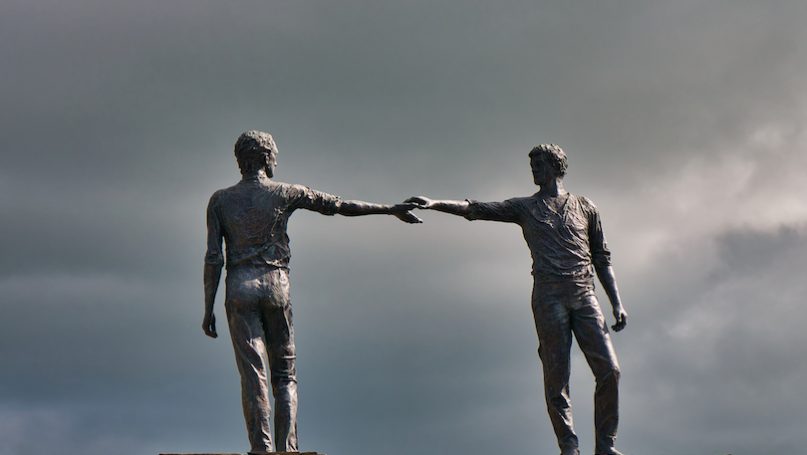
The Good Friday or Belfast Agreement (GFA) of 1998, that effectively ended the near three-decade long conflict in Northern Ireland, is approaching its twenty-fifth anniversary. The conflict in Northern Ireland, known to many as ‘The Troubles’, lasted roughly from 1966 to 1998. This protracted conflict, between Irish Nationalists or ‘republican’ paramilitary organisations, mainly the Irish Republican Army (IRA), and the security forces of the British state (whose counter-insurgency operations were supported in-part by loyalist paramilitary organisations), claimed approximately 3,500 lives. The Agreement was the result of more than a decade of negotiations between the numerous different parties involved in the conflict and was composed of numerous elements that together addressed the grievances and needs of these different parties and laid the foundation for a new system of governance for the province. The elements included: negotiating an end to the IRA’s armed campaign, the decommissioning of weapons used by both republican and loyalist paramilitaries, the demilitarisation of the province, policing reform, political reform, and an amnesty for members of paramilitary groups. The agreement was made possible with support from the US, the EU, and a high level of cooperation and engagement between successive British and Irish governments throughout the 1990s.
The Anglo-Irish agreement of 1985 was the first step toward the governments of Britain and Ireland moving toward some form of resolution to the conflict. The agreement involved the removal of an article from the Irish constitution which made an irredentist claim to the six counties that comprise Northern Ireland. The agreement was followed in the late-1980s by correspondence between Social Democratic and Labour Party (SDLP) leader John Hume and Sinn Féin (SF) leader Gerry Adams.
The 1990s saw numerous changes in the greater international environment which created a ripe moment for the resolution of the conflict. In an interview with the author, former-Taoiseach (Prime minister of Ireland) John Bruton argued that ‘the fall of communism was a key event paving the way for the signing of the GFA. The US was no longer dependent on the UK (in terms of security) leaving the Clinton administration with a freedom that previous US administrations did not have’. Additionally, by the early-1990s, the leadership of the IRA were ageing, had matured ideologically, and had become aware that they were not going to succeed by force.
1993 saw the ‘Downing Street declaration’: an agreement between Taoiseach Albert Reynolds and Prime Minister John Major which stated that the two governments would be working together closely in order to achieve some form of resolution to the conflict. A closer degree of cooperation at government level in addition to back-channel talks between Hume and Adams led to the IRA ceasefire of 1994, which although interrupted by the IRA bombing of London’s Canary Wharf in 1996, effectively lasted until the 1998 agreement, with some exceptions. Elections in both the UK and Ireland in 1997 saw the election of Tony Blair and Bertie Ahern respectively, two leaders who were deeply committed to making peace in Northern Ireland. The role of the Clinton Administration’s envoy George Mitchell, has been seen by many as being of vital importance in the latter stages of the negotiations.
After the Agreement
The signing of the agreement in April 1998 was met with celebration internationally, yet the months and years that followed were mired with spoiler-related violence and other frustrations. The Omagh bombing of August 1998 by a splinter group calling themselves the ‘Real’ IRA (RIRA), which claimed 29 lives, was the first major test for the agreement. A RIRA attack on MI6 headquarters in London in 2000, the Northern Bank robbery of 2004, and the killing of IRA member turned informant Dennis Donaldson in 2006 were all incidents that indicated that the ways of the past had not been fully put to rest for some in the republican movement. There were also attempts by loyalist paramilitaries, including the newly-formed ‘Red Hand Defenders’, to derail the peace process between 1998 and 2001; with their most notable act being the killing of journalist, Martin O’Hagan in 2001.
As outlined in the GFA, security sector reform, the release of prisoners and the decommissioning of weapons would all take place in the years that followed the signing of the agreement. The Independent Commission for Policing in Northern Ireland, chaired by former governor of Hong Kong Chris Patten, published its report in 1999, which led to the abolition of the Royal Ulster Constabulary (RUC), which was replaced by the Police Service of Northern Ireland (PSNI). The release or hundreds of prisoners, members of both republican and loyalist paramilitary organisations, began in the summer of 1998. By the summer of 2000, most political prisoners had been released. Fraught negotiations and disagreements concerning the decommissioning of arms by the IRA continued for over three years before the process began in 2001. The announcement that all IRA arms had been decommissioned came in 2005. In 2009, Loyalist paramilitaries issued a similar statement. Overall, much was achieved in the first decade following the agreement.
However, failure to form a functional power-sharing government was a reoccuring problem from 1998 until 2007. In the summer of 2007, following weeks of negotiations between SF and the Democratic Unionist Party (DUP), Martin McGuinness (SF) and Ian Paisley (DUP) agreed to form a power-sharing government, a feat that would have been unimaginable even half a decade before that. Like the GFA, the new partnership of McGuinness and Paisley was greeted with celebration and seen as proof that the agreement was both stable and successful. Yet, the formation of the government was followed by more spoiler-related violence from dissident republicans: the shooting of a policeman in Derry in 2008 was followed by a sniper attack in 2008 and then the killing of an off-duty British soldier in early-2009. The attacks were carried out by the Continuity IRA (CIRA) and RIRA. These two republican groups are small in terms of membership, yet staffed by motivated and seasoned volunteers with alleged links to cross-border criminality. The attacks were a reminder that the peace process was still strongly opposed by some.
2010 saw the signing of the Hillsborough Castle Agreement between the governments of Britain and Ireland. According to the terms of the agreement, issues related to policing and justice would be put under the control of the government of Northern Ireland and its institutions. The Stormont assembly in Belfast, the seat of devolved government in Northern Ireland, also voted in support of the agreement. The Hillsborough Castle Agreement was seen as another breakthrough for the peace process and for the development of a functional political system in Northern Ireland.
The Historical Enquiries Team (HET) was established in 2005 to investigate unsolved murders committed between 1968 and 1998. The aims of the HET were to work with the families of those who had been killed and to engage with the wider community in Northern Ireland. The team were provided with a budget of 30million GBP. Investigations into the Miami Show-band (1975) massacre and the killing of teenager Damien Walsh (1993) led to members of the HET publicly stating that their investigations had raised concerns about the seemingly high level of collusion between the British security forces and loyalist paramilitaries during the conflict. Although welcomed by many, the HET’s work received much criticism. An official report from the British government stated that the HET’s work was ‘inconsistent’ and ‘has serious shortcomings… and so risks public confidence’. The HET finished their work in 2014 after the PSNI received significant budget cuts. Further investigation into the role of state-sponsored loyalist death squads has since been carried out by Anne Cadwallader and the Pat Finucane centre in Derry. In 2022, the police ombudsman for Northern Ireland published another report highlighting collusion between the police and loyalist groups throughout the 1990s.
Controversy related to the families of political figures, such as Ian Paisley Jnr or Liam Adams, and political deadlock over issues related to language and education have created uncertainty and skepticism over the past decade and a half, which has been intensified by events since the Brexit referendum of 2016. Northern Ireland, like Scotland, voted to remain in the UK. The result of the referendum has led to worries concerning the creation of a hard border across the island of Ireland, Britain’s only land border with the EU. After years of negotiation, the ‘Northern Ireland protocol’ came into effect in January 2021, keeping Northern Ireland within the EU’s customs union and single market, while creating a type of ‘sea border’ between Northern Ireland and the rest of the UK. The protocol was seen as only a temporarily measure to resolve the crisis related to the border that was created by Brexit. In a further sign of change, in the British general election of 2019, Nationalist parties won more seats than Unionist parties for the first time in the history of Northern Ireland. This was followed by Northern Ireland electing its first Nationalist first minister in 2022.
In February 2023, a renegotiation of the Northern Ireland protocol began under the new British PM Rishi Sunak. Since 2021, DUP opposition to the protocol has been strong and a permanent arrangement that will satisfy all parties has been difficult to grasp. It has been argued by some that ‘the protocol leaves Northern Ireland inside the EU’. The role of the European court of justice as part of the protocol has caused consternation for Unionists and some conservatives. At the time of writing (February 17th), it has been announced by the British government that ‘progress has been made, but there are still some outstanding issues’ concerning negotiations for a new arrangement to replace the protocol.
Despite Brexit, spoiler-related violence, and other controversies, the core tenets of the GFA have been respected and Northern Ireland has transformed beyond recognition from where it was in the early-1990s. The agreement has survived extended periods of deadlock created by the inflexibility of both Nationalist and Unionist leaders and remains the foundation upon which Northern Ireland’s new political culture and institutions have been built.
The Success and the Applicability of the Agreement
To what can we attribute the success of the GFA? Some would argue that the success of the agreement has been due to its inclusive nature. After concessions were made by the Anglo-Irish agreement of 1985, the Republic of Ireland were later included as a negotiating partner by the governments of both John Major and later Tony Blair. The terms of the final agreement were made as favourable as possible to both governments and to all parties within Northern Ireland. The inclusive nature of the GFA and the role of constructive ambiguity in the agreement’s use of terminology have been essential elements in its success.
The agreement also came at a ripe moment during the liberal 1990s and before the 2000s, a decade that was to be characterised by the ‘War on Terror’, a climate that may not have allowed Gerry Adams to be granted a VISA to visit the US or to publicly visit 10 Downing Street. The IRA’s association with Muammar Gaddafi’s regime in Libya and also Palestinian armed groups during the Lebanese Civil War would not have been of benefit to SF in their attempts to gain sympathy and support in Washington and London. Thus, timing was another factor in understanding the success of the agreement.
Is the GFA still a model for conflict resolution in other parts of the world? After the fall of the Soviet Union, the 1990s saw a period of dominance by the US with the Clinton administration attempting to play the role of peacemaker in Bosnia, Northern Ireland, and Israel-Palestine. Yet since the 1990s, there has been numerous changes to the global political order and to how armed conflicts are managed by states. Additionally, we have seen the rise of populism and the emergence of resilient authoritarian states who practice what has been referred to as ‘illiberal peace-building’, a form of authoritarian conflict management that differs greatly from the liberal peace-building of the 1990s. Despite these changes, the GFA still serves as a role model for other protracted and seemingly unresolvable conflicts. There are numerous lessons that can still be learnt from the peace process of the 1990s and the 1998 agreement. Additionally, the successes of the post-conflict period provides examples of successful security sector reform, the implementation of an amnesty, and the decommissioning of arms. Former Taoiseach Bertie Ahern, a key figure in the peace process, has since played a role as peace builder in Papua New Guinea’s Bougainville region and also in Spain’s Basque country. It has also been argued by some that the GFA provided a blueprint for the peace process in Kosovo.
The GFA has also had its critics. Most notably, Sumantra Bose, who has criticised the incremental and slow-moving nature of the Northern Ireland peace process, which he argues provided time for spoilers to derail the overall process. Other common criticisms are that the two leading political parties, Sinn Féin and the DUP, have failed at post-conflict reconciliation and ‘dealing with the past’. Yet I would argue that this criticism is unfair considering the fact that the British government effectively withdrew support for the HET in 2014 and that support for those affected by post-conflict trauma has also not been adequately provided. Additionally, Northern Ireland never had a Truth and Reconciliation Commission (TRC) like South Africa. Criticism is also often directed at the two main political parties in the province for not being able to form a functional government. Yet, this may be due to the way in which the GFA was designed. In recent years, John Major has argued that the agreement should be amended to prevent one political party from collapsing the executive.
During an interview with myself this year, John Bruton argued that ‘The GFA is an agreement between the British and Irish governments which neither government wants to change’. Yet after twenty-five years of relative peace and successful cooperation, uncertainty surrounding the future of the province amid the growing prospect of unification with the Republic of Ireland in the future. The unification of the six northern counties that make up Northern Ireland with the Republic has been the long term and primary political aim of Sinn Féin since the 1920s. How such a process would be managed by the political establishments of both Northern Ireland and the Republic is a new debate that has slowly emerged since the Brexit referendum in 2016.
The Next Twenty-Five Years
The GFA allows for a ‘border poll’ or referendum on unifying Northern Ireland with the Republic of Ireland. Any discussion concerning unification was avoided by all parties for nearly two decades. In recent years, the issue of the border poll has resurfaced due to Brexit, demographic change in Northern Ireland, and the growth in popularity of Sinn Féin in both the Republic and Northern Ireland. In 2022, Nationalists or Catholics became a majority within the six counties of Northern Ireland for the first time since the establishment of the province in 1922. This demographic tipping point is something that people have been expecting for a long time, referred to by some as ‘the revenge of the cradle’. According to John Bruton: ‘It was seen at the time (1998) that the border poll would never take place.’ Bruton argued that Northern Irish politicians should focus on making Northern Ireland work as a political entity, yet conceded that this had become and increasingly difficult task due to the aspirations of Sinn Féin, who are now the largest political party in Northern Ireland.
Political deadlock has paralysed Stormont in recent years. It was announced in February 2023 that elections could now be postponed until 2024; thus Northern Ireland will not have a functional government in place for the twenty-fifth anniversary of the GFA. In the Republic, Sinn Féin have risen from receiving less than five per cent of the vote in general elections in the late-1990s to having an approval rating of more than thirty five per cent in 2021. This is in part due to the unpopularity of the Republic’s traditional parties in the wake of the 2008 financial crisis. In January 2023, Sinn Féin’s leader Mary Lou McDonald publicly stated that a United Ireland was within ‘touching distance after arguing the year before that a referendum on unification could take place ‘within five years’. Naturally, such statements have incensed many in the Unionist community. Her party has received much criticism from other political parties and commentators south of the border also. Additionally, it has become clear that the prospect of unifying Northern Ireland with the Republic would be an expensive one that many voters in the Republic may not find to be attractive. When asked what the response in Northern Ireland to Irish unity would be, a member of the unionist community from Belfast I interviewed argued that: ‘Protestants will respond in different ways… some will emigrate, others will integrate, some more slowly than others… and others will be an obstruction, with some resorting to violence’.
Some would argue that even the announcement of a border poll in the near future might trigger a violent response from certain sections of the Unionist community. Whether this violent reaction will be in the form of sporadic protests and demonstrations or in the form of organised paramilitary violence against the nationalist community or targets in the Republic, the threat of loyalist paramilitary violence is real and should not be dismissed by either London or Dublin. Dawn Purvis, former leader of the Progressive Unionist Party (PUP), a political party with links to loyalist groups, stated in 2019 that the UVF ‘hasn’t gone anywhere’. According to one source cited by the BBC in 2020, loyalist paramilitary groups in Northern Ireland currently have approximately 12,500 members. In March 2021, the Loyalist Communities Council (LCC) informed both the British and Irish governments that they were withdrawing their support for the GFA. The LCC was established in 2015 to represent the UDA, the UVF, and the Red Hand Commando organisation in unison. It was stated in their letter that their withdrawal of support for the GFA was in response to the creation of an Irish sea border. It is believed by some that arms caches have been hidden in remote areas for future use by both loyalist and republican paramilitary groups in the province. Overall, the influence of these organisations remains strong in certain areas of Northern Ireland and ‘peace walls’ have increased in number since 1998, with both communities being resistant toward their removal.
When considering how unification might happen, it should be remembered that Britain has a long history of poorly-managed departures from its former territories. Additionally, successive British governments since 2016, particularly the government of Boris Johnson, have acted in bad faith toward political parties in both Northern Ireland and the Republic concerning negotiations related to the Irish border. Sinn Féin are determined to hold a border poll within the next decade. If unification were to commence after a vote of support, it would have to be handled in a sensitive and meticulous way that would minimise the risk of conflict. Unification would have to be an inclusive process supported by external parties. The terms of such unification would need to be negotiated and implemented in a similar manner to that of the GFA. Involvement of the EU and the UN would be essential, while support from the US would likely be of great benefit. If unification were to be rushed or carried out in a way that excludes unionist political parties or civil society, it could be presumed that widespread disturbances or violence would follow. The security services of the Irish Republic would be unable and unsuitable for managing the task of keeping the peace and maintaining order. It is likely then that an intervention by the EU or UN would be needed in such a case.
Although the international order in which it was created has changed, the successes of the GFA can still be a blueprint for peace processes in other parts of the world. Political change over the last decade has seen the rise of a new politics that is fuelled by toxic social media content, the manipulation of emotions, and the resurrection of old grievances and prejudices. In such a climate, the next twenty-five years could prove to be a great deal more turbulent for Northern Ireland than the first twenty-five years after the agreement.
Figure 1: A dissident Republican march in Derry/Londonderry in January 2009 during the 37th anniversary of Bloody Sunday in the city. Although small in number, dissident republicans maintain at least two small armed groups, the Continuity IRA and the Real IRA. Dissident republicans were responsible for the deaths of two off-duty British soldiers less than six weeks after this march.
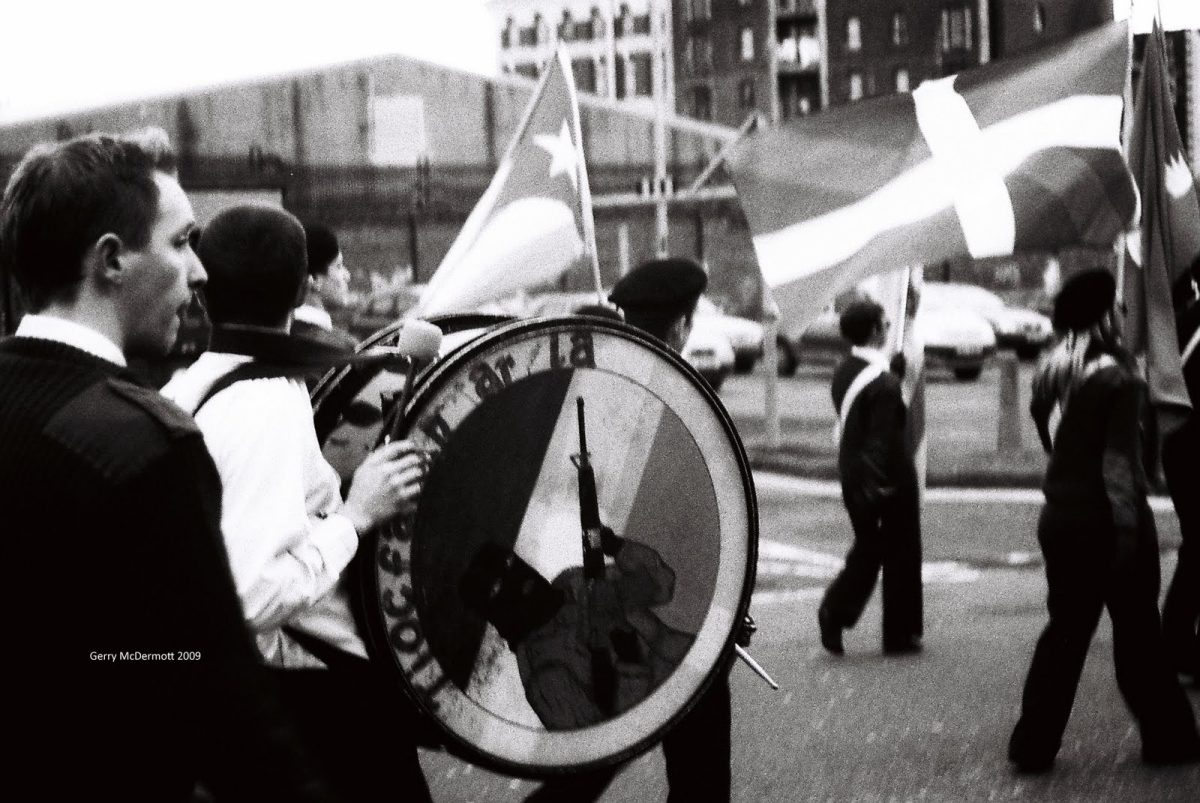
Figure 2: A plaque for Stephen Mc Conomy, a child who died in the conflict in Northern Ireland in 1982. Many deaths of non-combatants have never been investigated by the state. Funding for the Historical Enquiries Team was cut in 2014. Murals, plaques, and other monuments are common across Northern Ireland for remembering victims and volunteers.
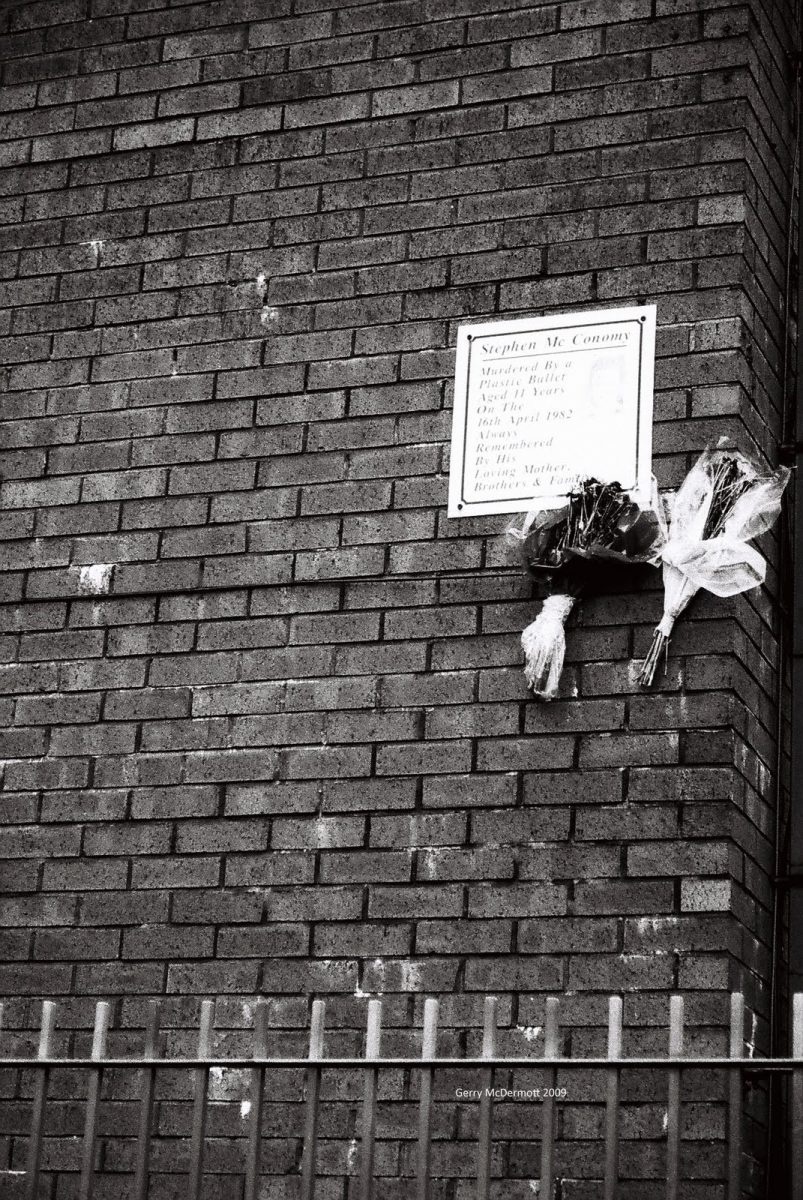
Figure 3: ‘No change’ sprayed across the old walls of Derry (2009), overlooking the city’s nationalist districts of the Bogside and Creggan, both areas with a long history of supporting republican groups. Due to skepticism and frustration regarding the Good Friday Agreement in some nationalist areas, graffiti such as this condemning or criticising the agreement can be a common sight.
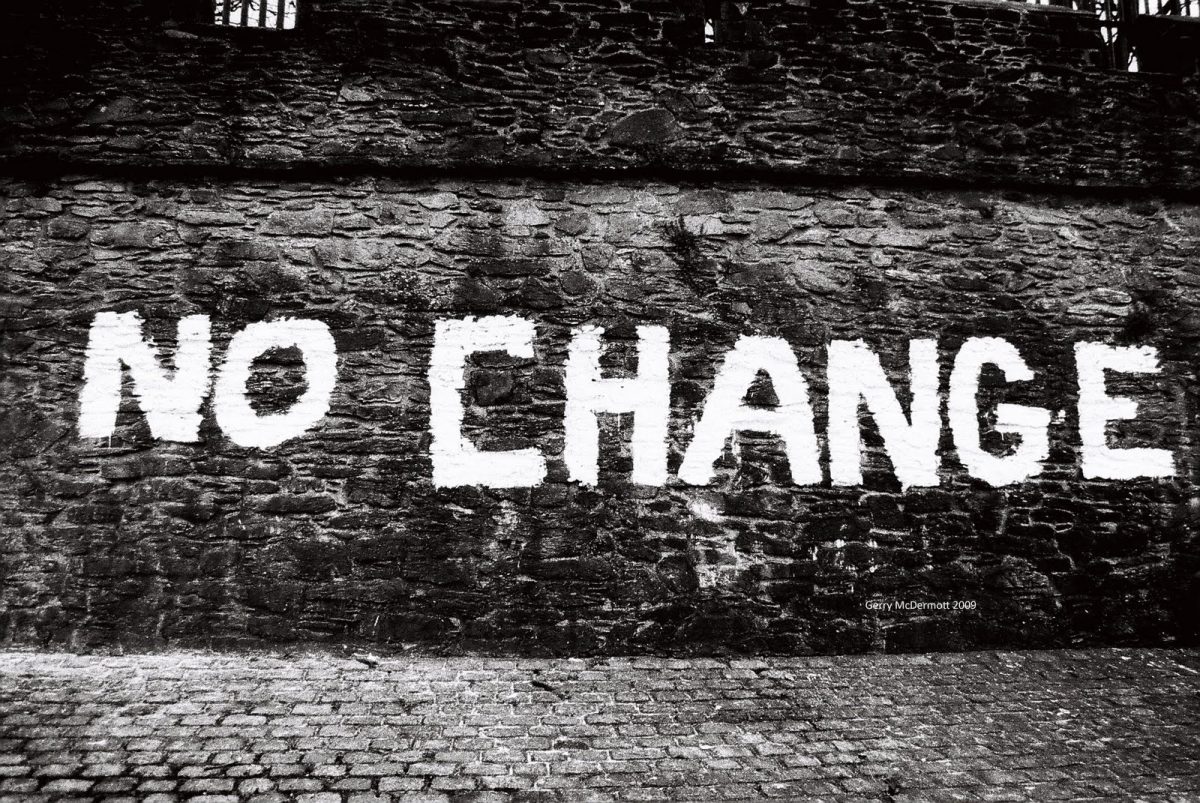
Figure 4: ‘RIRA/32CSM’ or ‘Real IRA / 32 County Sovereignty Committee’ graffiti sprayed across a wall outside of Derry’s walled city (2009). The 32CSM is the political pressure group of the real IRA, who continue to maintain an armed struggle for a united or ‘32 county’ Ireland. This spoiler group have been responsible for more than 30 deaths since the agreement. Graffiti expressing support for paramilitary groups such as the RIRA, often sprayed by teenagers, can be seen in many residential areas across Northern Ireland.
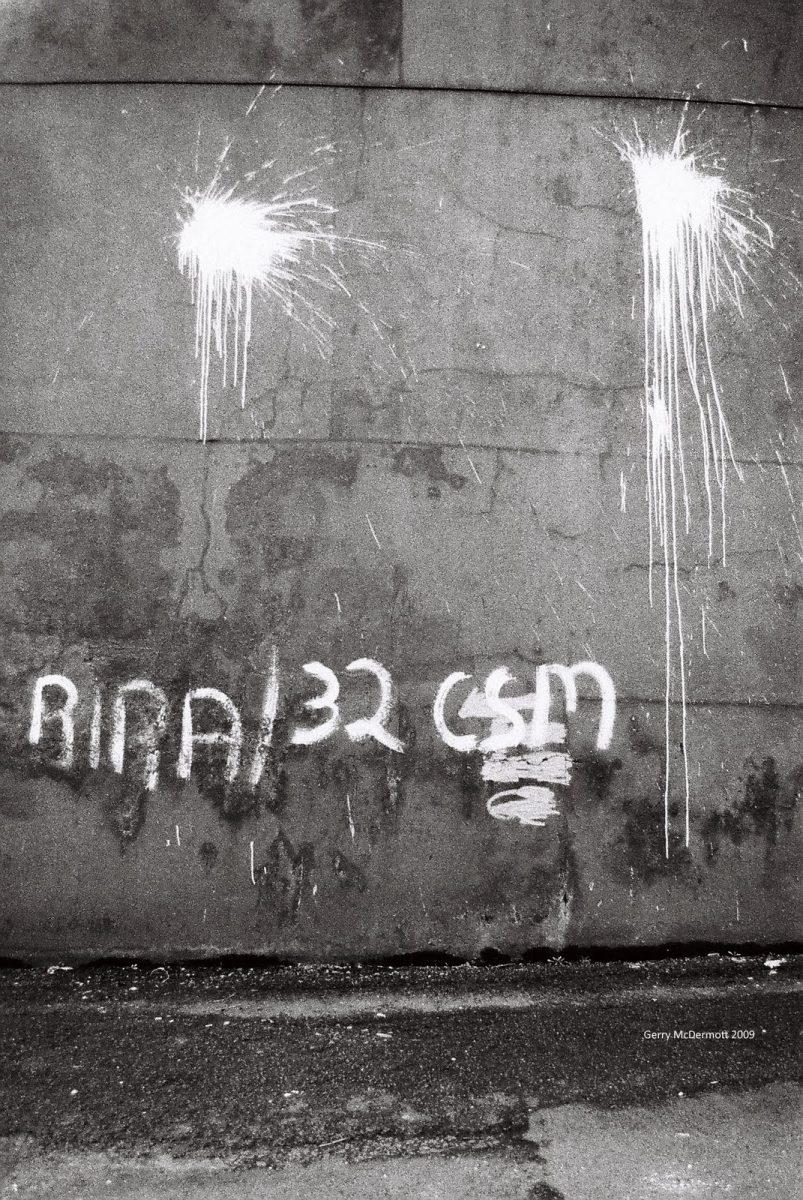
Author note: Special thanks to former-Taoiseach John Bruton.
Further Reading on E-International Relations
- Opinion – Northern Ireland’s ‘Dirty War’
- Opinion – Brexit and the Continued Troubles in Northern Ireland
- Challenges in the Museological Heritagization of the Troubles in Northern Ireland
- Reflections on the Troubles and the IRA in ‘The Secret Army’
- Northern Ireland as a Sacrifice Zone: The Lough Neagh Crisis
- The Glasnevin Necrology Memorial: Exhibiting Ireland’s Dark Heritage